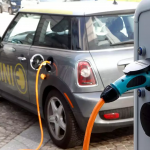Crown Group, a local auto parts manufacturer in Pakistan launched a two-door and two-person hatchback electric vehicle (EV) a few weeks ago. It costs Rs400,000. The company has three and four-person versions as well, all under Rs1million — quite affordable compared to existing combustion engine models. Contingent on the now-forgotten implementation of the Electric Vehicle Policy, the company intends to ramp up production having partnered with eight Chinese EV companies. In January, rickshaw maker Sazgar Engineering launched its first electric rickshaw as well. Other players are bringing EV buses. It seems the private sector is ready to change the game. The government, however, is lagging.
And that is a pity. Whether it is pushback from existing players (read: “Charging- III”, Dec 3, 2019), or it is an internal tussle between Ministry of Industries, and Ministry of Climate Change on jurisdiction, the government needs to resolve and move the policy into execution phase lest precious investments are turned away (read: “Charging-II”, Nov 28, 2019).
Whereas the latter is purely an administrative issue and easily resolvable, the former is not. Automakers manufacturing combustion engines should be incentivized to bring their own variants to the market. If they can’t beat EVs, they should join them — isn’t that the mantra? Of course, that is easier said than done. However, they need not fear too much competition, given that EVs are new, and untested. The infrastructure does not exist yet, and once the policy is kicked into action, it will take time for EV infrastructure to be built. By that time, they can up their game.
There are no two ways about it, and the government should go ahead with the policy. The more pertinent question is whether much can be expected from EVs right now. For one, the demand is direly missing for vehicles. The passenger vehicle segment has witnessed volumes shrink 43 percent in 8MFY20 against the corresponding period last year. Cost of borrowing is high — with the latest interest rate cut offering little reprieve.
To top that, even in a flourishing market, EVs will be a long shot for anyone — given Pakistani consumers are simply not familiar with the product category. They have never used electric vehicles before. Moreover, now when incomes are shrinking, car buyers would go for a sure thing, a popular Japanese make that has been seen trudging down the roads and likely used before as well. The EV players in Pakistan have an enormous task on their hands to market their products to hesitant car buyers, and to price them favorably. Globally, lithium ion technology is becoming cheaper and manufacturers are ramping production. Price points in the Pakistani market would matter given how expensive passenger cars are — and have become over the past two years.
Conventional wisdom suggests that EVs are here for the long-haul. Notwithstanding that the novel corona outbreak in China has contracted production as well as buying, and the effects are similar in the US and Europe. EVs have long-term positive impact on helping reduce reliance on imported oil and improving the environment by bringing carbon emissions down. So maybe EVs won’t start selling today or tomorrow in Pakistan. But the technology is much needed, and the investments are coming. Precious time may be lost if the country keeps looking the gift horse in the mouth.





